

Omnibook. ELL Students Benefit from Orton-Gillingham Techniques - IMSE - Journal. Orton-Gillingham: A Multisensory Structured Language Approach Part 4: Lesson Demonstration. Three Reasons Why Multisensory Learning is Food for the Brain. Multisensory learning (MSL) helps an individual learn by using more than one sense.

For children with dyslexia, the use of the visual, auditory, kinesthetic, and tactile modalities can be very helpful. A major component of the Orton Gillingham Approach is that it must be multisensory. This approach aligns perfectly with how our brains learn. When both teacher and student understand how we learn based on neuroscience, it results in a mutual “buy-in.” Let’s look at three reasons why multisensory teaching is so important. Stronger Neural Connections and Better Retention Experts believe that students remember what they learn while using multiple senses more effectively than while using one sense.
In Judy Willis’ book, “Brain Friendly Strategies for the Inclusion Classroom,” a study was conducted on learning how to juggle in order to support the theory of multisensory learning. Students Learn Differently We all learn differently and do not process information the same way. Resources. Addressing Dyslexia through Multisensory Instruction. Stratford Foundation, Inc. d/b/a Commonwealth Learning Center, Professional Training Institute, & Commonwealth Learning Online Institute Website Privacy Statement and Terms of Use Disclaimer Revised: 11/15/2011 ScopeThe Stratford Foundation Inc (Stratford) privacy statement applies to Stratford’s primary domain names commlearn.com, commlearntraining.com, commlearnonline.com and all its sub domains.
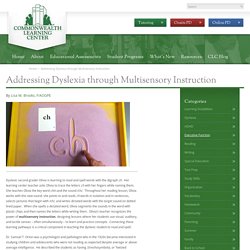
Each of these separate domains are referred to, collectively, as the Stratford Foundation Website. The Stratford Foundation Inc strives to protect user’s privacy to the fullest extent allowed by law. Data Collection and UsageThe Stratford Foundation Inc will not disclose personally identifiable information we collect from you to third parties without your permission except to the extent necessary including: – To fulfill your requests for services. – To protect ourselves from liability, or – To respond to legal process or comply with law. Phonogram List. Did you know? Our curriculum teaches students all of these phonograms, along with consistent and linguistically accurate spelling rules!
Learn more! Read about the importance of phonograms and the benefits of systematic and complete phonics instruction in our Research section. You may also be interested in a few of the supplemental products we created to help teach phonograms: Durable flashcards of all 75 basic phonograms. Forty-eight Advanced Phonograms Cards unlock thousands of advanced vocabulary words.Learn moreBuy Now. Programmes de langues structurés multisensoriels: contenu et principes d'enseignement. Ce qui est enseigné Phonologie et conscience phonologique La phonologie est l'étude des sons et de leur fonctionnement dans leur environnement.
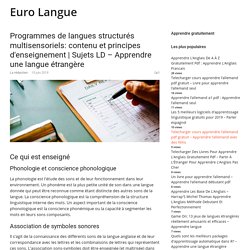
Un phonème est la plus petite unité de son dans une langue donnée qui peut être reconnue comme étant distincte des autres sons de la langue. La conscience phonologique est la compréhension de la structure linguistique interne des mots. Un aspect important de la conscience phonologique est la conscience phonémique ou la capacité à segmenter les mots en leurs sons composants. Association de symboles sonores Il s’agit de la connaissance des différents sons de la langue anglaise et de leur correspondance avec les lettres et les combinaisons de lettres qui représentent ces sons. Dyslexia International - Quelques notions de base pour enseignants. Section 3 3.
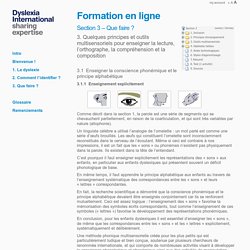
Quelques principes et outils multisensoriels pour enseigner la lecture, l’orthographe, la compréhension et la composition 3.1 Enseigner la conscience phonémique et le principe alphabétique 3.1.1 Enseignement explicitement. Multisensory Structured Language Teaching Fact Sheet - International Dyslexia Association. What is meant by multisensory teaching?
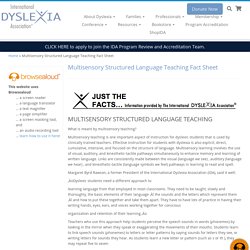
Multisensory teaching is one important aspect of instruction for dyslexic students that is used by clinically trained teachers. Effective instruction for students with dyslexia is also explicit, direct, cumulative, intensive, and focused on the structure of language. Multisensory learning involves the use of visual, auditory, and kinesthetic-tactile pathways simultaneously to enhance memory and learning of written language. Links are consistently made between the visual (language we see) , auditory (language we hear) , and kinesthetic-tactile (language symbols we feel) pathways in learning to read and spell. Margaret Byrd Rawson, a former President of the International Dyslexia Association (IDA), said it well: “Dyslexic students need a different approach to learning language from that employed in most classrooms.
Organization and retention of their learning. What is the rationale behind multisensory, structured language teaching? Comprehension. Dr. Multisensory Learning and Teaching for Dyslexic Students. Quick Facts about Multisensory Learning Not Just a Song and Dance Have you ever danced in mathematics, sung a song in science or painted in phys. ed?
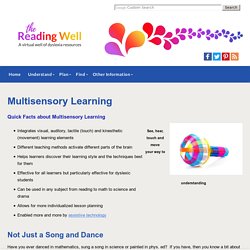
If you have, then you know a bit about multisensory learning. This creative kind of teaching doesn't have to be that unorthodox, since counting on your fingers is multisensory, but it definitely goes beyond the traditional approach to education that relies almost exclusively on vision (reading text) and hearing (listening to the teacher talk). For the dyslexic learner, it's an approach that should be fully explored. Multisensory learning taps into our visual, auditory and tactile senses plus motion (kinesthetic) though sometimes the last two are lumped together. Below is a short description of some of the kinds of techniques that fall under each of the learning strands. Dyslexia teaching points: Multi-sensory techniques for teaching science. Teaching Kids with Dyslexia - Multi-sensory Instruction.